I’ve visited the Cologne Cathedral in Germany many times and explored from the basement Treasury to the top of the Bell Tower. Still, my visit for the German National Tourist Board was the first time I’ve ever crawled around on the floor. Most people, me included, walk into the immense Dom and look UP. You can’t help it. This is a massive space, and so much is above eye level. It’s impossible to take everything in at once, so you find yourself staring in awe. My guide, Parthena Trellopoulou-Pauli, encouraged me to look beyond the greatness… to see the DETAILS… that make the Kölner Dom a real treasure. Let me share some of those fantastic treasures with you and show you WHY you need to visit the Cologne Cathedral and why you might want to crawl around on the floor, too.
The Cologne Cathedral In Germany
HOW did they do that? How could people hundreds of years ago build such a magnificent Cathedral without computers or OSHA?
Let’s start with a little bit of history. In the 9th century, one of Europe’s largest Cathedrals already existed on the site in Cologne (or Köln). Then, in 1164, Archbishop Rainald von Dassel brought the relics of the Magi (the bones of the three Kings who visited Jesus in Bethlehem) to Cologne, making the city one of the most important pilgrimage sites in the world. Naturally, they needed a magnificent building worthy of such honor. When the old Cathedral mysteriously burned in April 1248, the decision was made. Archbishop Konrad von Hochstaden laid the cornerstone for the new Cologne Cathedral on May 15, 1248. 632 years later, in 1880, the final stone was laid.
However, working on such a large project is never really finished. Weather, the elements, and war took their toll on the structure. Today, 100 workers are permanently employed to fix, rebuild, and maintain the Dom. If you get the chance, go around to the back of the Dom. You can see the mason’s yard and all the statues under repair.
Wait…. THE three Kings?
Those of you who sat through many a Christmas Pageant (Or remember the story from the book of Matthew) may remember that the Three Kings or Wise Men came from the East bringing gifts of Gold, Frankincense, and Myrrh to the infant Jesus. In the 4th Century, Helen, mother of the Roman Emperor Constantine, went on a quest to find remains and was lucky enough to come across them in Persia. They moved the bones to Constantinople for a while, and then in the 5th Century, they found a home in Milan. (Around 50 years later, the church began celebrating the“Feast of the Epiphany” to honor the relics properly). In 1164, Holy Roman Emperor Frederick Barbarossa took the relics from Milan and brought them to Cologne. The Cathedral kept the skulls safe for years until finally, in 1225, the elaborate resting place was finished.
Today, the skulls of the Three Kings or Magi rest in a magnificent golden shrine near the Altar of the Cathedral. When you stand near it, you finally get an idea of how LARGE it is and how much work and detail went into creating this shrine. The basilica-shaped box is 83 inches long and 60 inches tall and rests on a hydraulic lift so the priest can lower it for special occasions.
Note: Originally, the relics were taken out and people could touch them to promote healing. Later, to save the relics from being damaged by so many sticky fingers, people received slips of paper that had been in the shrine with the relics.
But what’s most amazing is the detail of the gold and enamel work. Every face has a different expression; every arch is decorated with gems and enamel, and you see hands, noses, and tiny details, all covered in hammered gold. Follow the arches around the shrine to see a pictorial story of the history of salvation, from the beginning of time to the last judgment. And for those of you who are paying attention- you even get a 4th King carrying a present next to the original three. This is Otto IV. Since he paid for the box, he got to be on it too.

Behind the Altar, you will find the oldest stained glass windows in the Cologne Cathedral, dating back to the 13th century. Look carefully. Each panel has a story from the Bible. On the right, you will find stories from the New Testament, and on the left, a matching story from the Old Testament. (For example, the birth of Jesus is next to the birth of Isaac). Side note- Since the Cologne Cathedral in Germany sits close to the Cologne HBH (Main Train Station), which was a prime bombing target, these windows were carefully removed, packed up, and stored during WWII to keep them out of the blast zone.
While walking down the south side of the Nave, Parthena spotted a few men in Lederhosen. She very proudly showed them the “Bavarian Windows”… yes, complete with Bavarian Colors and the image of King Ludwig 1 himself. The windows were donated for an anniversary celebration, and the main window showed St. Stephen’s martyrdom. The guys in Lederhosen were not impressed.
Shame, they are nice windows.
Protecting the Dom from Destruction
A short aside…
In 1937, before the first bombs fell, Max Loosen, the Cathedral Vicar, saw what was coming and began to take precautions. He ordered that crates be built to house all the treasures so they could be loaded and transported to safety at a moment’s notice. In 1940, the Medieval Stained Glass windows were removed and packed away. Finally, the pieces that couldn’t be moved, the statuary, and the intricately carved choir stalls were all packed up in place. The column statues were wrapped up and boxed, then given extra support to prevent anything from falling on them from above. They covered the choir stalls with sandbags and established a new Fire Brigade to save the Cathedral from fire. The Cathedral was bombed 12 times, including one which took out a considerable portion of the west wall. But the overall structure stood solidly. For more information, read Cologne Cathedral in World War II by Niklas Möring
Treasury
When you are ready, head downstairs to the Treasury. (Be aware there is an added charge of around 3 Euros for visiting these rooms.) The Cologne Dom Treasury is one of the largest in Germany despite having been robbed a few times. (This is why it’s now underground.) In it, you will find gold chalices, historical garments, and relics from other saints. Also, art, illuminated manuscripts, and even a shrine holding three links from St Peter’s chain.
Down a different Staircase, you will find an archeological site. The Dom is the third church built on this site, and archeologists always learn something new. I was fascinated by the foundation. (As a Californian, keeping buildings steady is kind of important to me). The foundation goes down 7 meters (about 23 feet) with basalt and rubble set in perfect layers to bear the weight of the massive structure.
Going UP!

For an unrivaled view from the Cologne Cathedral in Germany and an incredible workout, you can’t beat climbing the 533 steps up to the viewing platform of the South Tower. Stone steps, worn in a bit from the thousands of feet that have climbed over the years, rise in a spiral. The occasional window slits give you peeks at the view to come. Stop for a while in the Bell Chamber. It houses eight bells, including the St Peter’s Bell, the largest (at TONS) free-swinging bell in any church worldwide. And it is LOUD! If you time your climb, you can stand in the bell chamber as they chime. Don’t worry; your hearing will eventually return. Look out to the distance; some say you can see the Siebengeberge, which is 30 km away. I like looking for the gargoyles and intricate carvings on the towers. Imagine making such art, then putting it up where few people would have the chance to see it.
Ok, so why was I crawling on the floor?
The mosaic floors have fabulous detail. The tiny 1 cm square tiles unbelievably cover the most cathedral floor (1350 square meters or 14,500+ square feet) with beautiful images, including the Archbishop Hildebold with a model of the old Cathedral, the coat of arms from various Bishops and archbishops, flowers, and more. The floor, made by Villeroy & Boch, the famous porcelain maker, took 14 years to install. And most people walk right over it. Do yourself a favor, stop, get close to it, and really look.
The detail, like the detail in every corner of the Cathedral, is amazing.
Ready to see the Cologne Cathedral in Germany?
More Ways to Enjoy your Trip to Cologne


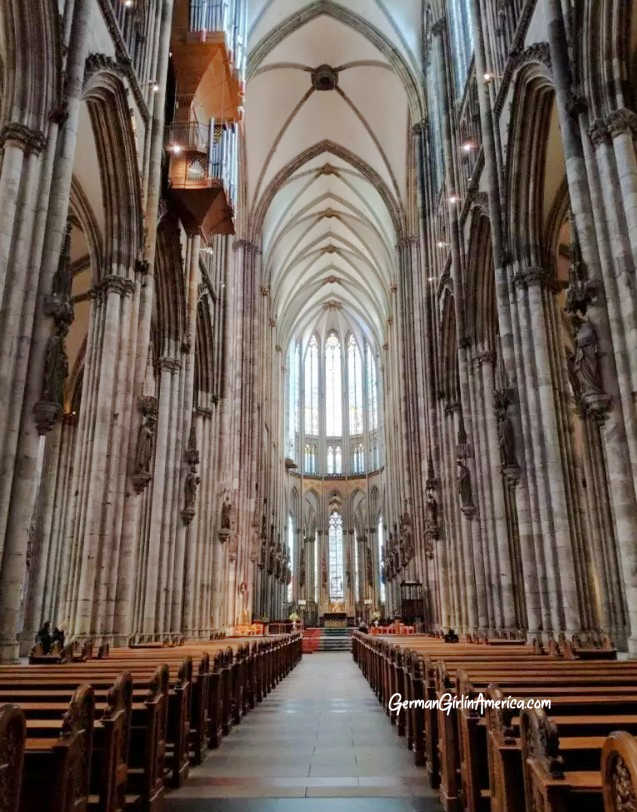
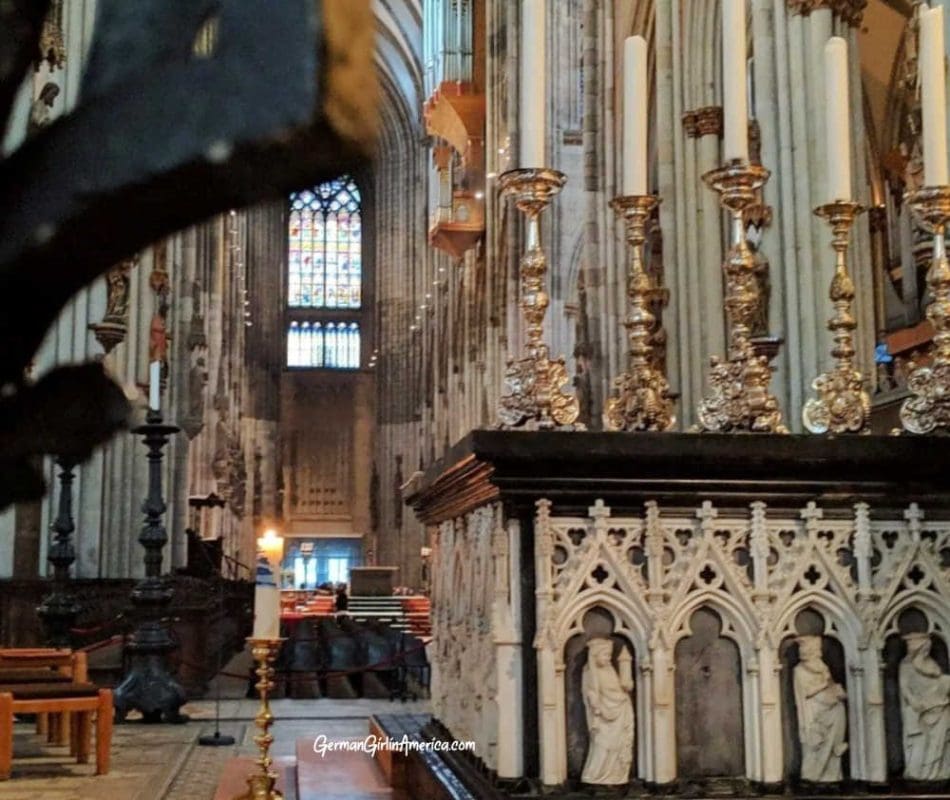
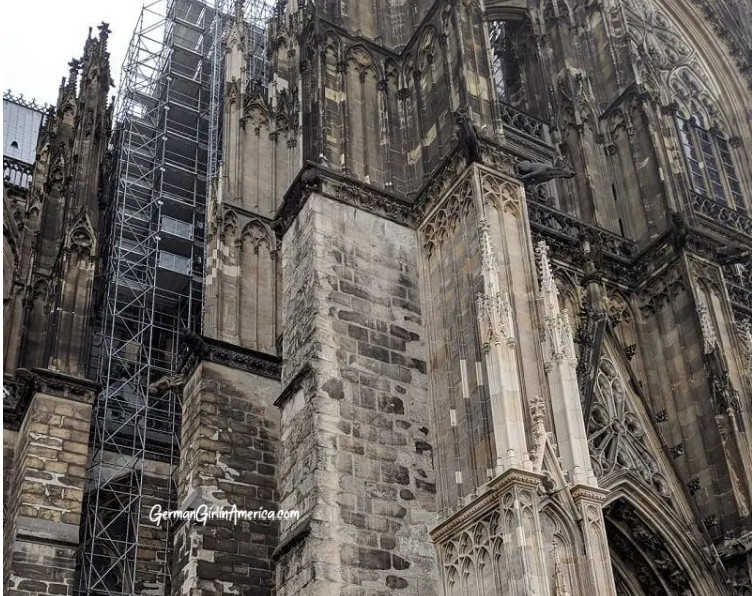

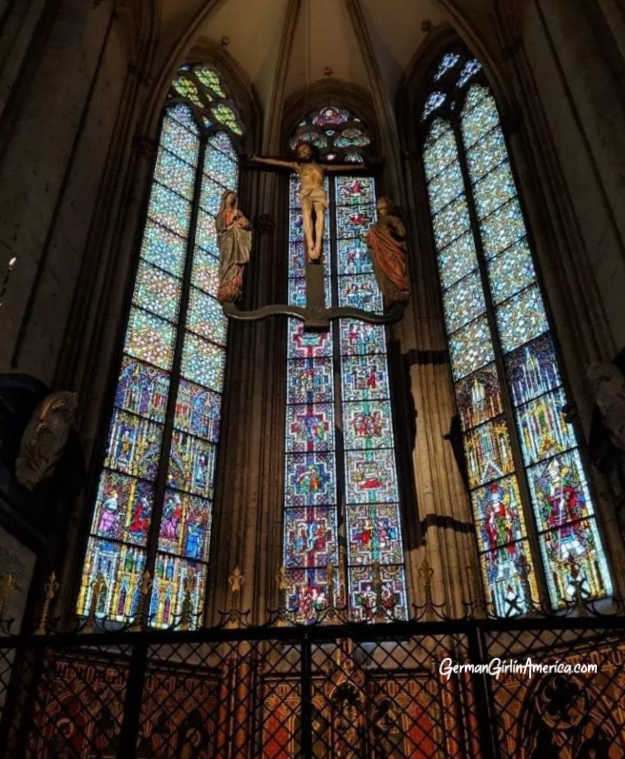


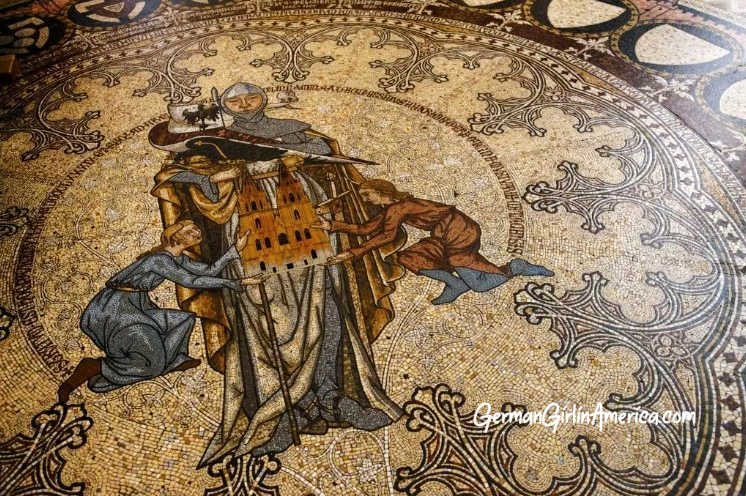
Thanks for this great post on the Kölner Dom.
I would like to add two things to your list: first the magnificent stained glass windows by Gerhard Richter installed in 2007, a modern take on the old idea of telling a story with a window. A great example of the fact that the cathedral is continuously in change.
And then I strongly recommend to book a guided tour on top of the roof of the cathedral. Unfortunately one has to book it well in advance.
Thanks for the info. I would love to take a tour of the roof! Sadly, it was a drizzly day, and I only had a few hours this time.
Next trip for sure!